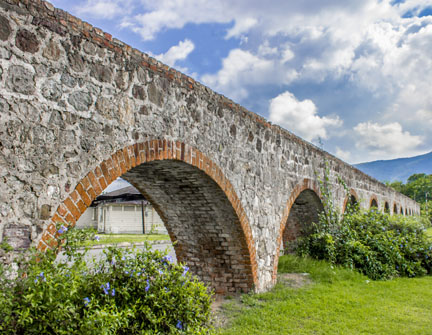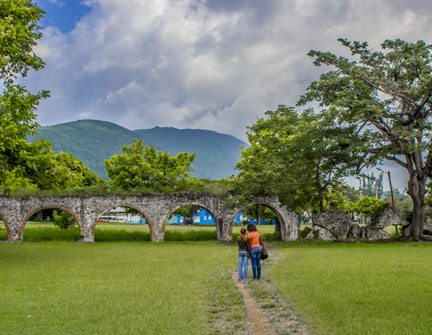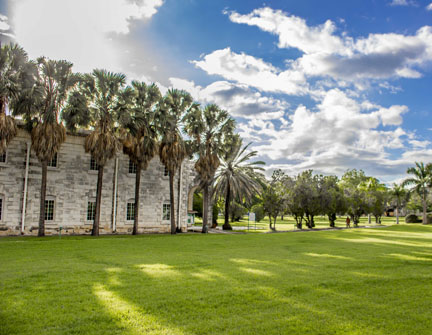Mona, Jamaica is the founding campus of the unique, multi-part, multi-national University of the West Indies. The square mile site welcomed its first undergraduates – 33 medical students from across the West Indies or now, more often, the Caribbean – in October 1948. To medicine was added Natural Science in 1949, Arts in 1950 and, gradually, the full range of the modern university.
Historic Site

The campus was chosen not just for its salubrious location, a plateau in the arms of the mountains on the outskirts of the city of Kingston, but also because it came with basic but usable accommodation built during World War II (1939 – 1945) when the site was a wartime camp. Gibraltar Camp as it was known, offered refuge to evacuees from the British island fortress of Gibraltar at the tip of Spain and, eventually, to Jewish refugees marooned in Spain and Portugal. There was even a civilian internment camp on the site in 1943.
The barracks style buildings constructed to house these long-stay visitors became the university’s offices, lecture rooms, laboratories, halls of residence and recreational and other facilities, before the construction of new buildings started in the early 1950s.
A Past Steeped in Plantation History
The Mona site’s history dates back even further. The site holds the ruins of the sugar works yards for two of St Andrew’s sugar estates, Mona to the south and Papine to the north. The estates were divided by a small road called Shed Lane, small remnants of which remain; and linked by the cut-stone aqueduct that can still be seen across the campus. The aqueduct, dating from the mid-1700s, drew water from the Hope River and carried it to the sugar mills of the larger Hope Estate north of Papine, and to Papine and Mona.
By the end of the 19th century, Papine was owned by Mona’s owner, who was consolidating land holdings in the area. These lands were purchased by the Kingston water authorities in the 1920s, for the water rights that they controlled. During this period, much of the land was leased to small farmers, many of them East Indians who raised dairy herds and also supplied Kingston with vegetables and pulses. The area was also known as offering pasturage for the city’s livestock.
A Link to World War Two

It was the south-eastern part of this land, some 252 acres - that became the location for Gibraltar Camp.
In 1944, when the bulk of the evacuees were returned home to Gibraltar, and when many of the refugees had found onward locations, the camp was taken over by the military authorities. The Jamaica Batallion, the Home Guard, a Royal Air Force (RAF) Transit Camp and eventually an Ex-Servicemen’s training facility were all located in the vicinity at various times during this period of 1944 – 1947.
The camp was handed from the military to the Public Works Department and then on to what was then known as the University College of the West Indies (UCWI) at the end of December 1947. And, after swift work to reconfigure the buildings to suit the needs of the nascent university, the UCWI welcomed its first students – 23 men and 10 women – in 1948.
The Beginning of The Modern UWI
The University’s establishment had been recommended in 1945 by the Irvine Committee, which spent three months touring the region and hearing from various interests in early to mid-1944. The Committee, chaired by Sir James Irvine of St Andrew’s University in Scotland, was part of the wider Asquith Commission investigating calls for higher education in the British colonies, The Irvine Commission recommended a single regional university, with medicine as the first focus but a speedy broadening of the academic offering. The institution was to have a Royal Charter, and to be fully residential, the better to fulfil its role of developing a cadre of young West Indians. To build academic credibility, it was to be apprenticed for some time to a known institution that would grant external degrees – this was the origin of its early name the University College of the West Indies; the parent institution being the University of London.
After much deliberation and taking into account factors including population and facilities, the Commission recommended that the location be Jamaica.
The university achieved independent degree-granting status in 1962, as the University of the West Indies. By then, the university had acquired the Imperial College of Tropical Agriculture at St Augustine in Trinidad, which became its second campus. A College of Arts & Science established in Barbados in 1963 eventually crew into the third campus, Cave Hill. The Open Campus, formalised in 2008, drew on the pioneering experience of the Extra Mural Department which dated back to the university’s founding, as well as distance teaching. The University Centres in non-campus countries fall under the Open Campus.
UWI Today

Today, The UWI is the region’s premier educational institution, with faculties offering a wide range of undergraduate, masters and doctoral programmes in Humanities and Education, Science and Technology, Science and Agriculture, Engineering, Law, Medical Sciences and Social Sciences. But amid the concerns of the present, the past remains visible across the Mona campus, where a number of heritage signs and monuments call attention to the material remnants of the site’s varied history. These include cut stone Roman style aqueducts, an 18th century building re-purposed as a Chapel and much more.

